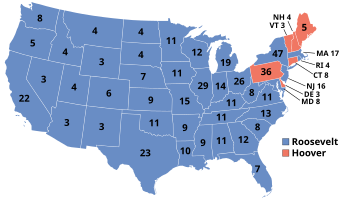
Back انتخابات الرئاسة الأمريكية 1932 Arabic Præsidentvalget i USA 1932 Danish Präsidentschaftswahl in den Vereinigten Staaten 1932 German Elecciones presidenciales de Estados Unidos de 1932 Spanish انتخابات ریاستجمهوری ایالات متحده آمریکا (۱۹۳۲) Persian Yhdysvaltain presidentinvaalit 1932 Finnish Élection présidentielle américaine de 1932 French הבחירות לנשיאות ארצות הברית 1932 HE 1932-es amerikai elnökválasztás Hungarian Pemilihan umum Presiden Amerika Serikat 1932 ID
| |||||||||||||||||||||||||||||
531 members of the Electoral College 266 electoral votes needed to win | |||||||||||||||||||||||||||||
|---|---|---|---|---|---|---|---|---|---|---|---|---|---|---|---|---|---|---|---|---|---|---|---|---|---|---|---|---|---|
| Turnout | 56.8%[1] | ||||||||||||||||||||||||||||
| |||||||||||||||||||||||||||||
 Presidential election results map. Blue denotes those won by Roosevelt/Garner, red denotes states won by Hoover/Curtis. Numbers indicate the number of electoral votes allotted to each state. | |||||||||||||||||||||||||||||
| |||||||||||||||||||||||||||||
The 1932 United States presidential election was the 37th quadrennial presidential election, held on Tuesday, November 8, 1932. The election took place against the backdrop of the Great Depression. The incumbent Republican President Herbert Hoover was defeated in a landslide by Democrat Franklin D. Roosevelt, the governor of New York and the vice presidential nominee of the 1920 presidential election. Roosevelt was the first Democrat in 80 years to simultaneously win an outright majority of the electoral college and popular vote, a feat last accomplished by Franklin Pierce in 1852, as well as the first Democrat in 56 years to win a majority of the popular vote, which was last done by Samuel J. Tilden in 1876. Roosevelt was the last sitting governor to be elected president until Bill Clinton in 1992. Hoover became the first incumbent president to lose an election to another term since William Howard Taft in 1912, and the last to do so until Gerald Ford lost 44 years later. The election marked the effective end of the Fourth Party System, which had been dominated by Republicans. It was the first time since 1916 that a Democrat was elected president.
Despite disastrous economic conditions due to the Great Depression, Hoover faced little opposition at the 1932 Republican National Convention. Roosevelt was widely considered the front-runner at the start of the 1932 Democratic National Convention, but was not able to clinch the nomination until the fourth ballot of the convention. The Democratic convention chose a leading Southern Democrat, Speaker of the House John Nance Garner of Texas, as the party's vice presidential nominee. Roosevelt united the party, campaigning on the failures of the Hoover administration. He promised recovery with a "New Deal" for the American people.
Roosevelt won by a landslide in both the electoral and popular votes, carrying every state outside of the Northeast and receiving the highest percentage of the popular vote of any Democratic nominee up to that time. Hoover had won over 58% of the popular vote in the 1928 presidential election, but his share of the popular vote declined to 39.6% in 1932. Socialist Party nominee Norman Thomas won 2.2% of the popular vote. Subsequent Democratic landslides in the 1934 mid-term elections and the 1936 presidential election confirmed the commencement of the Fifth Party System, which was dominated by Roosevelt's New Deal Coalition.[2] Roosevelt's election ended the era of Republican dominance in presidential politics that had lasted since the beginning of the Civil War and the election of 1860.
- ^ "National General Election VEP Turnout Rates, 1789-Present". United States Election Project. CQ Press.
- ^ History of American Political Parties
© MMXXIII Rich X Search. We shall prevail. All rights reserved. Rich X Search

